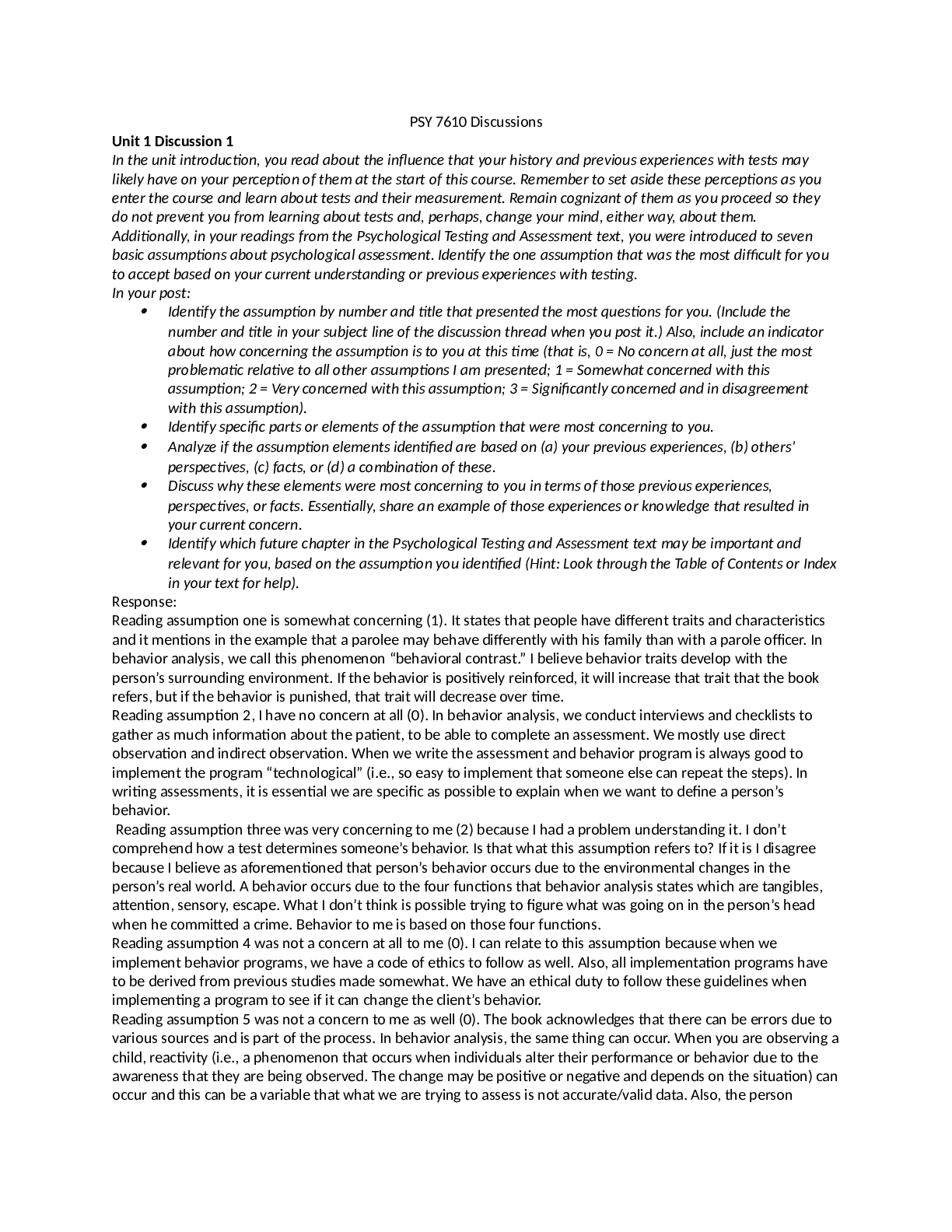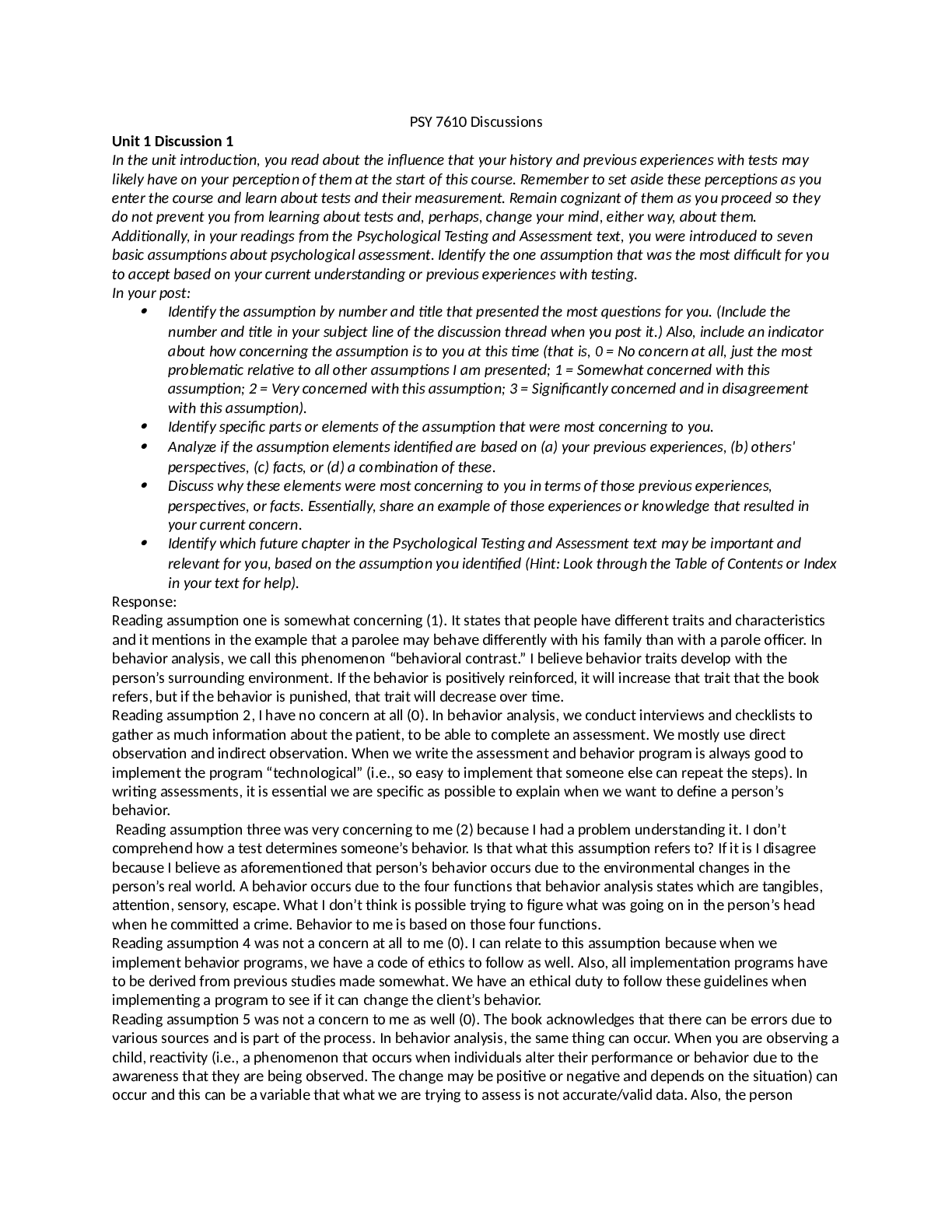PSY 7610 Discussions
Unit 1 Discussion 1
In the unit introduction, you read about the influence that your history and previous experiences with tests may
likely have on your perception of them at the start of this course. Remember to set aside these perceptions as you
enter the course and learn about tests and their measurement. Remain cognizant of them as you proceed so they
do not prevent you from learning about tests and, perhaps, change your mind, either way, about them.
Additionally, in your readings from the Psychological Testing and Assessment text, you were introduced to seven
basic assumptions about psychological assessment. Identify the one assumption that was the most difficult for you
to accept based on your current understanding or previous experiences with testing.
In your post:
Identify the assumption by number and title that presented the most questions for you. (Include the
number and title in your subject line of the discussion thread when you post it.) Also, include an indicator
about how concerning the assumption is to you at this time (that is, 0 = No concern at all, just the most
problematic relative to all other assumptions I am presented; 1 = Somewhat concerned with this
assumption; 2 = Very concerned with this assumption; 3 = Significantly concerned and in disagreement
with this assumption).
Identify specific parts or elements of the assumption that were most concerning to you.
Analyze if the assumption elements identified are based on (a) your previous experiences, (b) others'
perspectives, (c) facts, or (d) a combination of these.
Discuss why these elements were most concerning to you in terms of those previous experiences,
perspectives, or facts. Essentially, share an example of those experiences or knowledge that resulted in
your current concern.
Identify which future chapter in the Psychological Testing and Assessment text may be important and
relevant for you, based on the assumption you identified (Hint: Look through the Table of Contents or Index
in your text for help).
Response:
Reading assumption one is somewhat concerning (1). It states that people have different traits and characteristics
and it mentions in the example that a parolee may behave differently with his family than with a parole officer. In
behavior analysis, we call this phenomenon “behavioral contrast.” I believe behavior traits develop with the
person’s surrounding environment. If the behavior is positively reinforced, it will increase that trait that the book
refers, but if the behavior is punished, that trait will decrease over time.
Reading assumption 2, I have no concern at all (0). In behavior analysis, we conduct interviews and checklists to
gather as much information about the patient, to be able to complete an assessment. We mostly use direct
observation and indirect observation. When we write the assessment and behavior program is always good to
implement the program “technological” (i.e., so easy to implement that someone else can repeat the steps). In
writing assessments, it is essential we are specific as possible to explain when we want to define a person’s
behavior.
Reading assumption three was very concerning to me (2) because I had a problem understanding it. I don’t
comprehend how a test determines someone’s behavior. Is that what this assumption refers to? If it is I disagree
because I believe as aforementioned that person’s behavior occurs due to the environmental changes in the
person’s real world. A behavior occurs due to the four functions that behavior analysis states which are tangibles,
attention, sensory, escape. What I don’t think is possible trying to figure what was going on in the person’s head
when he committed a crime. Behavior to me is based on those four functions.
Reading assumption 4 was not a concern at all to me (0). I can relate to this assumption because when we
implement behavior programs, we have a code of ethics to follow as well. Also, all implementation programs have
to be derived from previous studies made somewhat. We have an ethical duty to follow these guidelines when
implementing a program to see if it can change the client’s behavior.
Reading assumption 5 was not a concern to me as well (0). The book acknowledges that there can be errors due to
various sources and is part of the process. In behavior analysis, the same thing can occur. When you are observing a
child, reactivity (i.e., a phenomenon that occurs when individuals alter their performance or behavior due to the
awareness that they are being observed. The change may be positive or negative and depends on the situation) can
occur and this can be a variable that what we are trying to assess is not accurate/valid data. Also, the person
Read More


